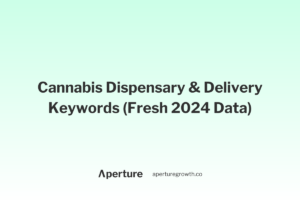“Give a CBD company blog topics, and they can post for a few months. Teach a CBD company how to come up with blog topics, and they can post for a lifetime.”
Although we had to hijack an adage to make our point, our point stands:
If your CBD company is going to successfully use blogging to acquire paying customers, you’re going to need more than a list of CBD blog topics.
Instead, you’ll need a system for predictably coming up with blog topics that, when turned into high-quality posts, can drive purchases from your target audience.
In this post, we’re providing you with one version of a topic generation system. It’s built around the assumption that you’ll be using your blog as a part of your SEO strategy; optimizing your blog posts for SEO and using them as a larger part of your SEO strategy is the primary way to see an ROI from your efforts.
Now look – we know you came here for CBD blog topics. We’ve come up with 149 ideas to get you started (see the table of contents below to scroll to them). But more important than simple ideas is understanding how to come up with content ideas that are a good fit for your unique CBD business, so that’s where this article is focused.
Why Should CBD Companies Blog?
For a more in-depth discussion on SEO for CBD brands, see our article on CBD SEO strategy.
To appreciate why we make such a big deal over CBD blog topics, and blogging in general, it makes sense to learn about the benefits that blogging can have for your CBD business.
We look at blogging through the lens of SEO, because unless you’re optimizing your content to drive organic traffic and bolster your website, blogging won’t be a profitable endeavor – at least not something you should invest heavily in.
SEO-focused blogging helps your money pages rank higher
The primary benefit of blogging may be a bit hard to understand if your CBD brand hasn’t yet begun doing SEO.
Writing blog posts that cover topics relating to your products can help your money pages rank higher.
By money pages, we mean your product pages and category pages. Writing blogs on the same topics, and linking them back to these pages, can help them rank better in organic search.
For instance, if you want your CBD gummies category to rank better, writing 5-10 articles about CBD and CBD gummies and linking them all to this page can improve this category page’s ranking, as well as the rankings of products that fit that category.
The reason this topical approach works is that Google wants to show pages for a topic from a website that is an authority on the topic.
If you want to be an authority for your product categories, and therefore rank better for those high-intent searches, start by using blog content to establish authority on topics surrounding your product.
SEO-focused blogging drives revenue and email signups
In addition to helping your valuable, transaction-focused pages to rank, your blog posts themselves can drive revenue and email signups – if they rank well and drive organic traffic.
Blogging, as a strategy, is valuable because it allows you to capture increasing amounts of traffic, month-over-month.
Even if your product and category pages were infinitely optimized, their traffic would eventually plateau because there are only so many people searching directly for the products you have to offer.
SEO-focused blogging solves this problem: it allows you to widen the net of people who come in contact with your business.
Some of these people will purchase quickly, others might just sign up for an email list – either way, you’re acquiring new customers and growing an audience that will result in more and more revenue over time.
The trick with blogging is to find topics that indicate potential product interest, but aren’t explicitly focused on your products; our topic generation system accounts for this.
Blogging builds customer trust & brand affinity
CBD companies with high-quality blogs have an easier time building trust with potential customers.
There’s a lot people want to know before going with a hemp-derived supplement, and offering them valuable and free information positions you as trustworthy and authoritative.
And with SEO-focused blogging, readers come to you, not the other way around; you don’t have to be pushy to get them to take notice of your products.
Neither of these factors necessarily exist with paid ads. While these ads can be educational, they still involve co-opting someone’s social feed or search engine page in order to plug your company – often effective, but not as valuable when it comes to building deep customer relationships.
In an industry plagued by bad products and false claims, the CBD company that goes out of its way to help people solve their problems via high-quality content is at a distinct advantage.
How to Come Up With CBD Blog Topics for Your Brand
Let’s get down to business – how can your CBD brand consistently come up with CBD blog topics that your audience will find relevant AND that will drive business value?
The basic premise is simple:
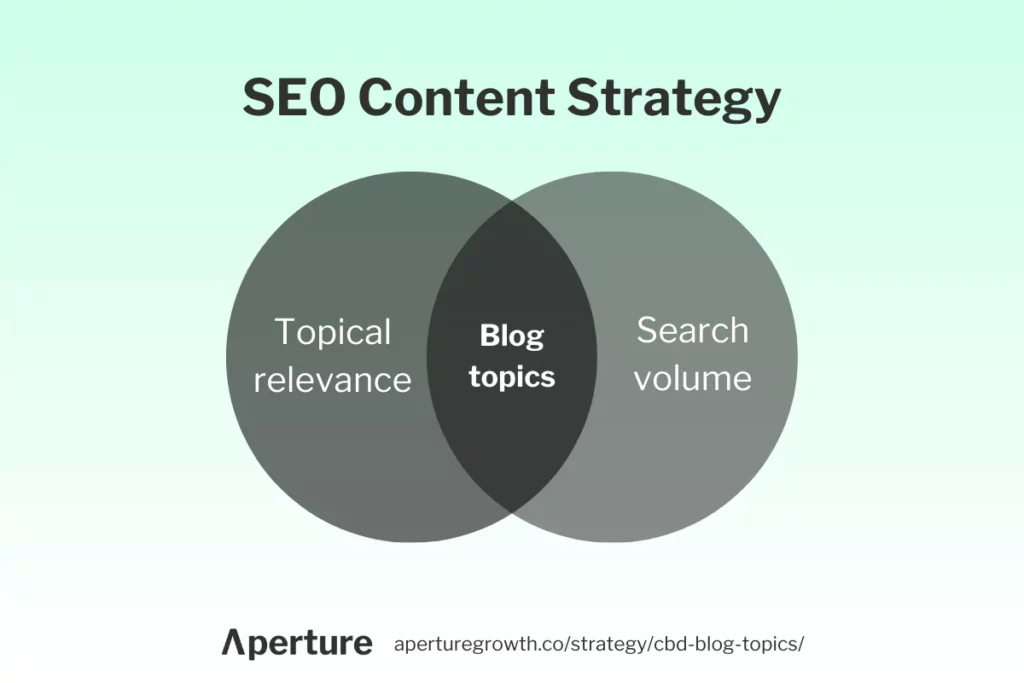
Some version of this image applies any time you’re coming up with a CBD content marketing strategy. But let’s go more in-depth on how to find topics that fit this venn diagram.
1. Identify your target audience & their pain points
The basis for your CBD blog topics is your audience. What does your target audience need to know as they research which product is best for them (if any)? What would they want to learn about?
By writing about topics that are relevant to your ideal customer as they move toward a purchase, you can attract people who are likely to buy your products – via SEO. You can also share your content through your email and social media channels to continue providing value to current customers.
Depending on how established your brand is, you probably already know who your audience is. But if you don’t, simply ask yourself what problems your products solve, and who your products solve these problems for.
This follows the pain point–audience framework. The pain point is the problem, the audience is the group of people who have this problem and would benefit from your product.
Some examples:
- Your products solve the pain point of joint pain and post workout recovery for athletes
- Your products solve the pain point of menopausal pain and other menopause-related complications for middle-aged women
- Your problems solve the pain point of not enough strong CBD oil options for people who are dealing with severe discomfort
- Your products solve the pain point of not enough vegan CBD gummies on the market for vegans
There are many ways you might characterize the pain point you solve and the people you solve it for – it could be people who are of a certain age, people with certain conditions, people with specific lifestyle choices, or even people who are using a certain product (but who want to stop).
2. Brainstorm content ideas
Now that you know who you’re speaking to, coming up with content ideas becomes a breeze: you write about what your target audience is searching for on Google.
Let’s take an example from the previous section:
- Your products solve the pain point of joint pain and post workout recovery for athletes and people with active lifestyles
Right off the bat, we can identify a few things our target audience might be searching:
- Can CBD help me with my athletic pursuit or activity (e.g. running or powerlifting)?
- Can CBD help me with a problem that’s come up as a result of this pursuit (e.g. joint pain, shoulder pain, etc.)?
- How does CBD compare to other cannabinoids for my specific problem?
Let’s take it a step further, this time using these broad categories to draw out specific topic ideas:
- Can CBD help me with my athletic pursuit or activity (e.g. running or powerlifting)?
- CBD for dancers
- CBD for swimmers
- CBD for runners
- CBD for yoga
- CBD for cyclists
- CBD for hiking
- CBD for lifting
- CBD for tennis
- Can CBD help me with a problem that’s come up as a result of this pursuit (e.g. joint pain, shoulder pain, etc.)?
- CBD for pain
- CBD for inflammation
- CBD for shoulder pain
- CBD for joint pain
- CBD for back pain
- CBD for rotator cuff pain
- CBD for tennis elbow
- CBD for bone fracture
- How does CBD compare to other cannabinoids for my specific problem?
- CBD vs. delta 9 THC for pain
- CBD vs. delta 8 THC for pain
- CBD vs. CBG for pain
- CBD vs. CBN for pain
- CBD vs. CBC for pain
If you can understand your audience and their broad pain point, you can come up with many specific sub-pain points to target with unique pieces of content.
We can’t prove it, but it took us just five minutes to come up with the ideas above. And all of these ideas can be made into full blog posts that help your target audience and drive sales and email signups.
Now, throw all these ideas in a spreadsheet:
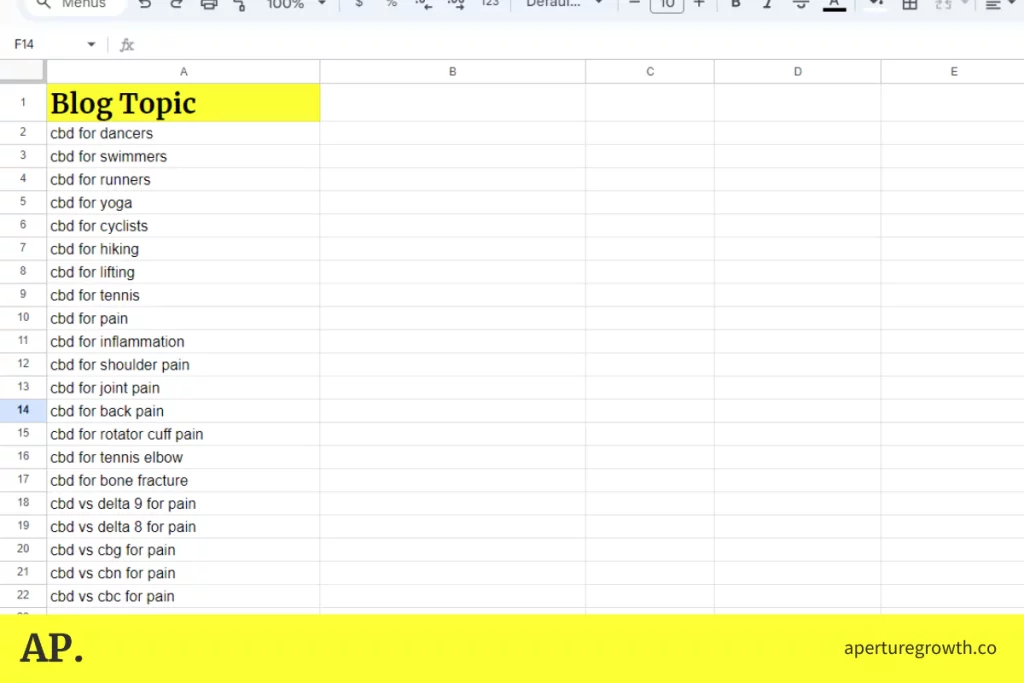
3. Validate & adjust ideas using keyword data
Related: CBD Keyword Research
Although it may be tempting to dive right into content creation once you have your CBD blog topics, you’ll first want to validate these topic ideas for SEO.
Essentially, topic validation is the process of ensuring that there is a demand for content on the topic and that your company can reasonably rank for the topic.
This ensures that the content you produce will drive business value. On social media, you don’t always have the privilege of knowing what people want. With search, you do.
Just refer to the diagram at the beginning of this section: our goal is to find topics that a) our audience cares about and that b) are profitable from a business standpoint.
The exact metrics you use to make these determinations will vary depending on the SEO tool you use (we use SEMrush at our agency). What you’ll want to look for, though, is keywords that have some search volume and fairly low competition.
Different platforms measure competition differently; SEMrush uses a scale of 0-100. For newer brands, we try to stay below 30 for the first six months, or until we gain significant traction.
For our example, we’ll only choose keywords that have 40 or more monthly searches and a difficulty of 30 or below.
Forty searches may not seem like much, but the data in these tools is often conservative (we have one post for a client that targets a keyword that supposedly has 50 monthly searches; it drives 200 clicks per month).
Keyword validation example
To make keyword validation more concrete, we’re going to look at two examples from the list of above topics.
The first keyword is [cbd for runners]:
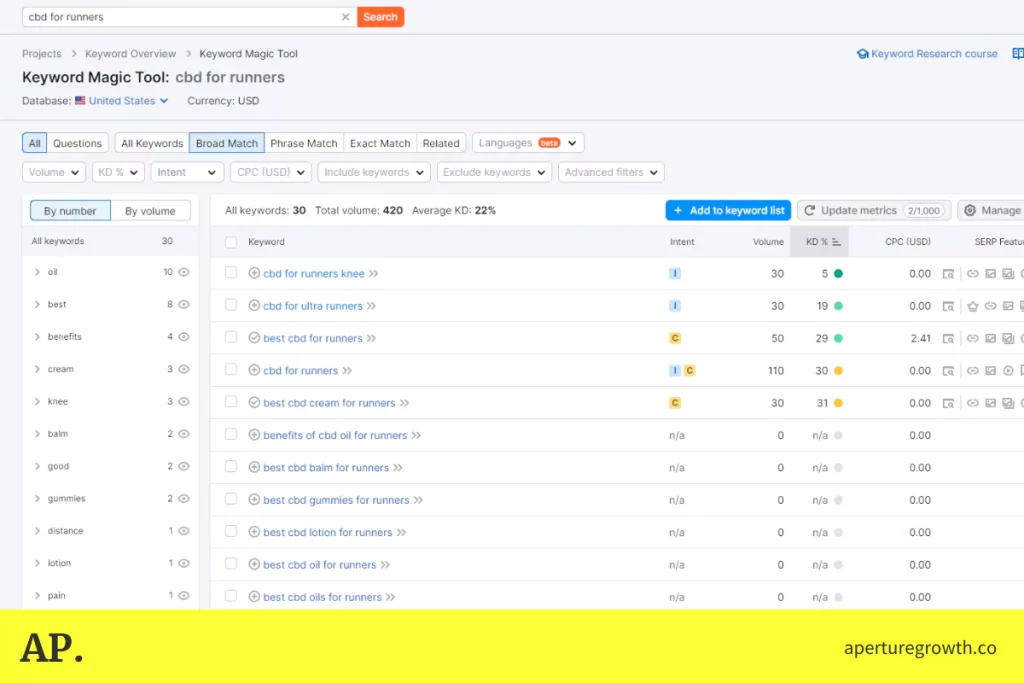
With 420 monthly searches (some of these are for products, but still) and an average difficulty score of 22, this would be a good topic for our athletic CBD brand to target with a blog post.
Now let’s try another of our topics, [cbd for inflammation]:
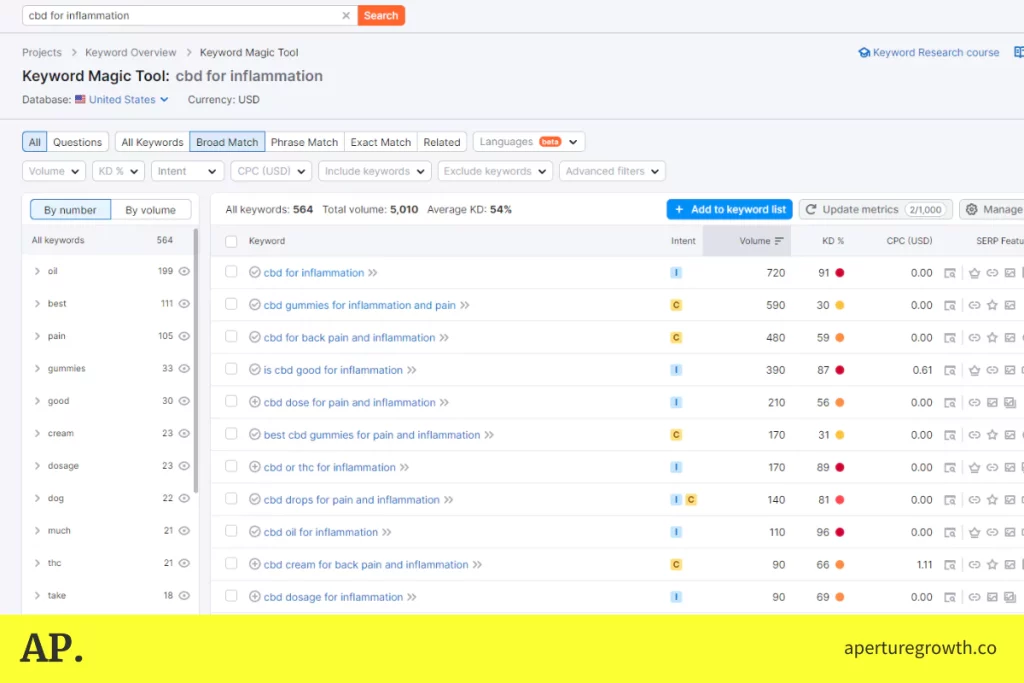
Wow! Quite a bit of search volume – over 5,000 – but also a high difficulty score. This keyword is likely dominated by very high-authority sites. It might still make sense to write an article for the topic, but not until our brand has built up quite a bit of authority.
Note that for topics that contain many subtopics, it’s worth examining these sub topics more specifically to see if there’s a lower-competition version of the topic you could target.
For example, in the screenshot above, there is a lower-difficulty contingent of keywords in this group: searches looking for the [best cbd gummies for inflammation] or [best cbd oil for inflammation].
The subtopic of [best cbd for inflammation] may be worth targeting with a blog. Many large health-related affiliate sites already target these types of product-related keywords, however, so you might still want to wait.
As you move down the list, record the volume and competition data in your spreadsheet, like so:
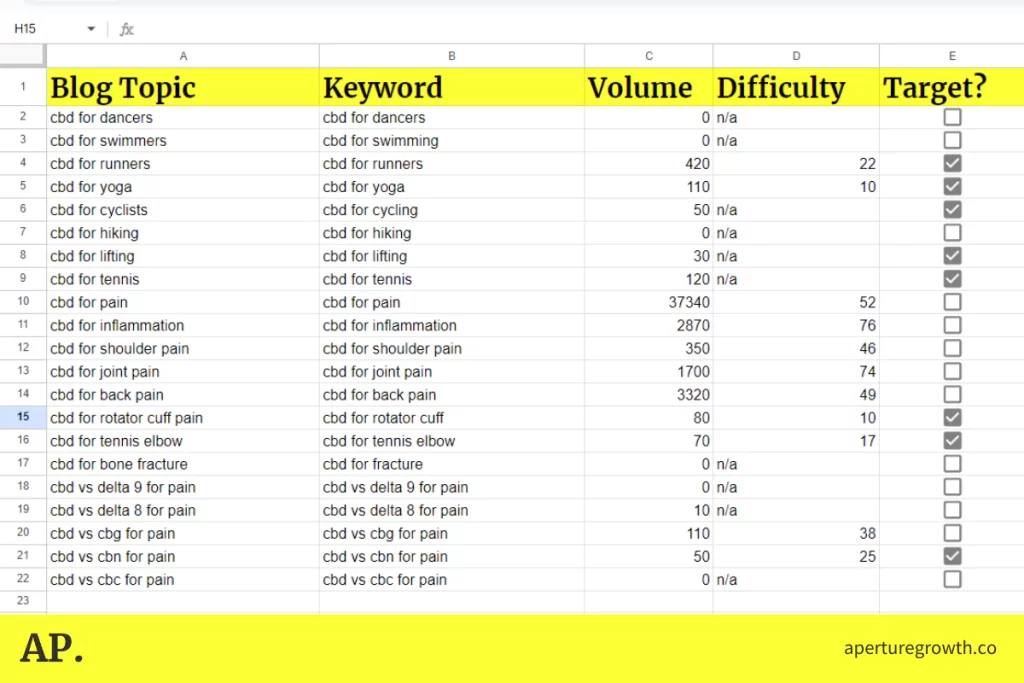
Keyword patterns
One more quick keyword research tip: don’t just validate the ideas you already have. Try to extrapolate a pattern from your current ideas, then put this pattern into a keyword research tool to get more ideas.
For our brand, one major pattern (see our topic list above) is [cbd] for [discomfort or problem that results from athletics].
Based on this, we can put [cbd for] into SEMrush and see if there are other topics that make sense for our business that we haven’t thought of. Filter the keywords so lower-difficulty topics show up first.
Scrolling through, we see “[cbd for golf].”
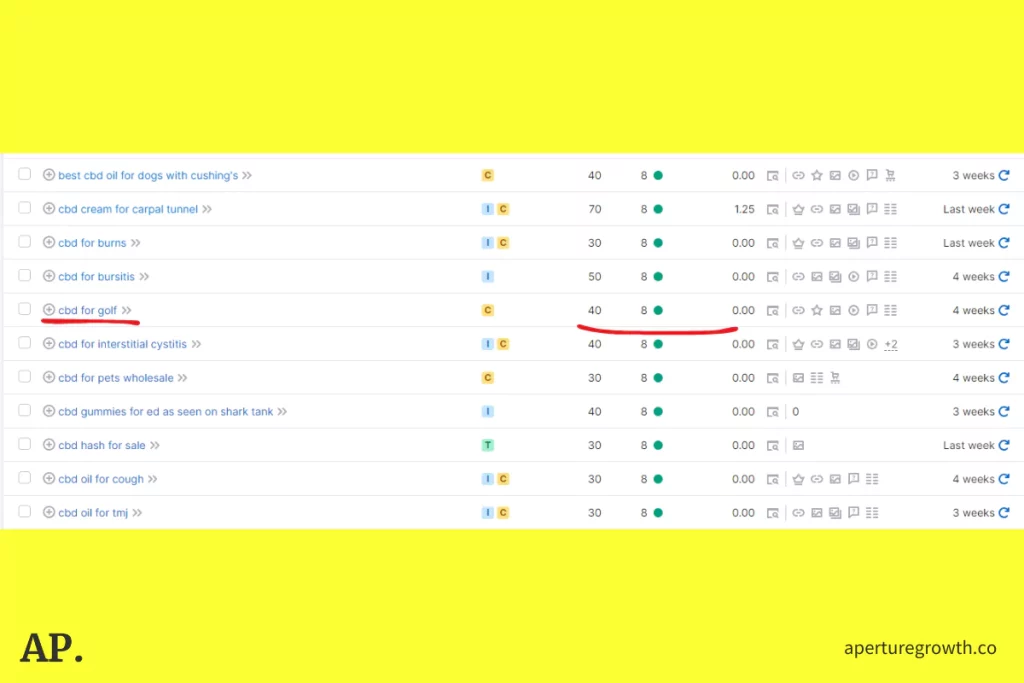
That’s a good keyword for our brand.
Another example, this one from our category of [cbd] vs [other cannabinoid] for pain. [cbda vs cbd for pain] might be a good topic as well.
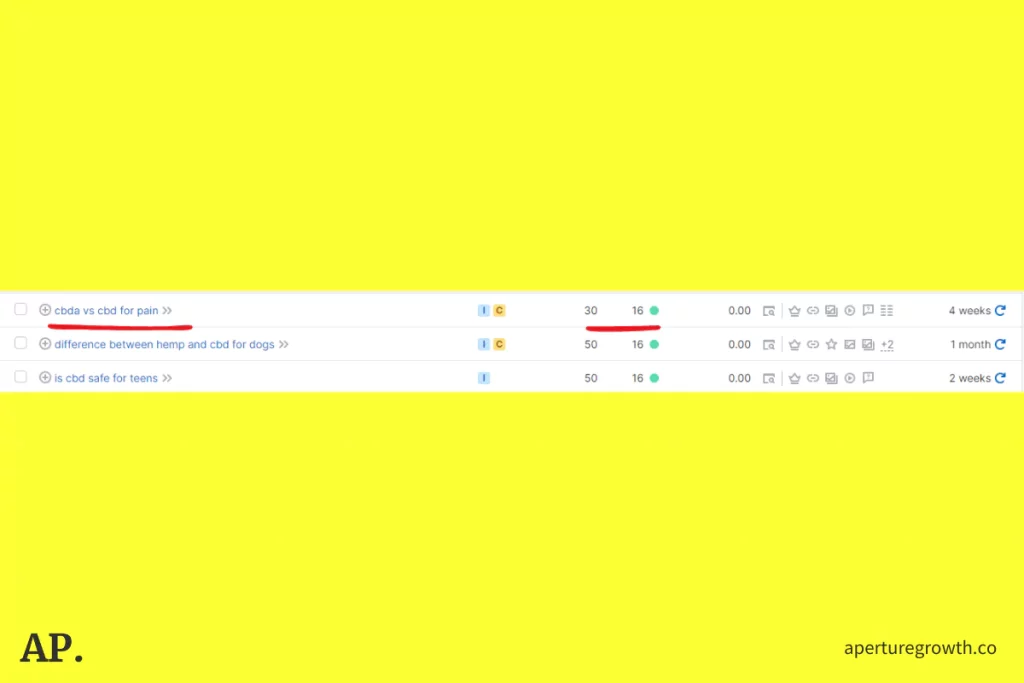
Use the patterns you’ve already established to go find more ideas. Filter by difficulty and volume, and it becomes even easier to find great topics.
Once you identify a keyword that looks good, research it by itself. Often, there will be other, lower-volume variations that you didn’t see when looking through a large list of keywords.
Step Four: Plan your content calendar
Once you’ve validated your blog topics, it’s time to schedule the winning topics into a content calendar.
In the long run, it doesn’t really matter how you prioritize your keywords. If they’re good topics, they’re good topics. However, for new sites, we recommend producing content on the lowest-competition topics first so that you can achieve early rankings and build the required momentum to rank for harder terms.
We simply deleted all the topics that didn’t fit our criteria (for a client, we usually save these topics and revisit them later), and organized the ones that did into a calendar, like so:
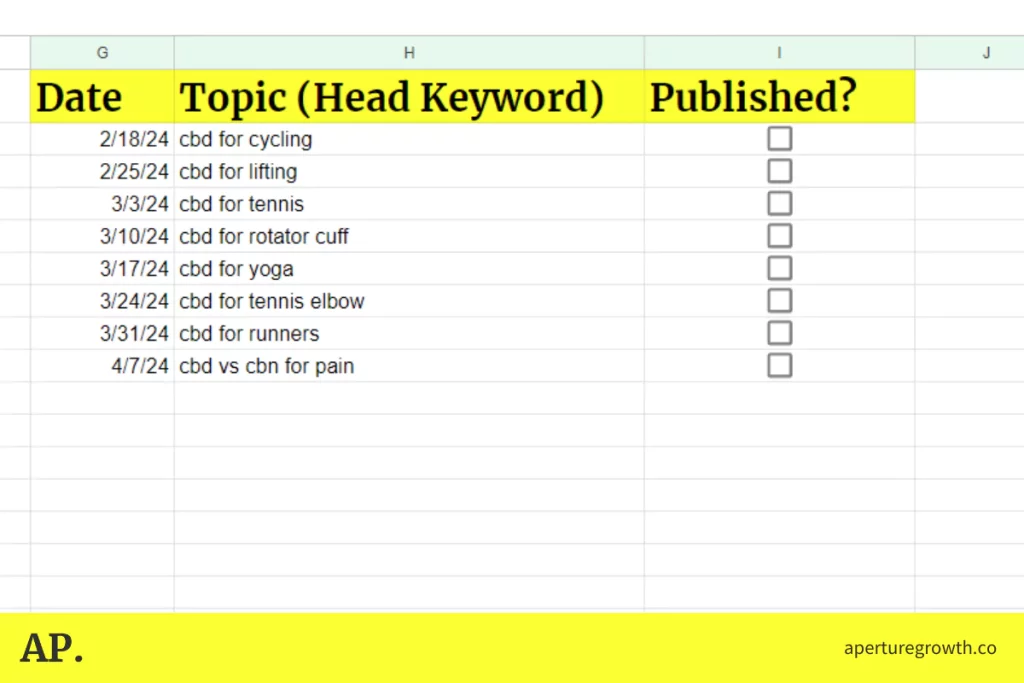
149 CBD Blog Topics
Here are 149 CBD blog topics to consider for your content calendar.
How to Use CBD (10 Ideas)
- How to take CBD oil
- How to take CBD gummies
- How to take CBD gel capsules
- How much CBD should a beginner start with?
- How many CBD gummies should I take?
- How much CBD is too much?
- CBD dosage
- How much CBD to take for anxiety
- How much CBD to take for pain
- How much CBD to take for sleep
CBD Use Cases (50 Ideas)
- What is CBD good for?
- CBD for pain
- CBD for inflammation
- CBD for anxiety
- CBD for stress
- CBD for sleep
- CBD for focus
- CBD for energy
- CBD for adhd
- CBD for joint pain
- CBD for knee pain
- CBD for nerve pain
- CBD for nausea
- CBD for high blood pressure
- CBD for neuropathy
- CBD for sex
- CBD for skin
- CBD for sciatica
- CBD for back pain
- CBD for diabetes
- CBD for ibs
- CBD for rheumatoid arthritis
- CBD for seizures
- CBD for headaches
- CBD for migraines
- CBD for chronic pain
- CBD for cancer
- CBD for depression
- CBD for seasonal depression
- CBD for menopause
- CBD for muscle pain
- CBD for tooth pain
- CBD for copd
- CBD for heart health
- CBD for eczema
- CBD for foot pain
- CBD for gout
- CBD for hair growth
- CBD for tendonitis
- CBD for tension headaches
- CBD for hip pain
- CBD for restless leg syndrome
- CBD for psoriasis
- CBD for tmj
- CBD for tinnitus
- CBD for leg nerve pain
- CBD for carpal tunnel
- CBD for cramps
- CBD for essential tremor
- CBD for vertigo
Cannabinoid Comparisons (30 Ideas)
- CBD vs. THC
- CBD vs. delta 9 THC
- CBD vs. delta 8 THC
- CBD vs. CBG
- CBD vs. CBN
- CBD vs. CBC
- CBD vs. CBDa
- CBD vs. HHC
- CBD vs. THCp
- CBD vs. THCa
- CBD vs. THC for pain
- CBD vs. delta 9 THC for pain
- CBD vs. delta 8 THC for pain
- CBD vs. CBG for pain
- CBD vs. THC for sleep
- CBD vs. delta 9 THC for sleep
- CBD vs. delta 8 THC for sleep
- CBD vs. CBG for sleep
- CBD vs. THC for anxiety
- CBD vs. delta 9 THC for anxiety
- CBD vs. delta 8 THC for anxiety
- CBD vs. CBG for anxiety
- CBD vs. CBN for sleep
- CBD vs. THC for nerve pain
- CBD vs. CBC for anxiety
- Full spectrum CBD vs. broad spectrum CBD
- Full spectrum CBD vs. CBD isolate
- Broad spectrum CBD vs. CBD isolate
- Delta 8 THC vs. full spectrum CBD
- Delta 8 THC vs. broad spectrum CBD
CBD Legality & Safety FAQs (10 Ideas)
- How old do you have to be to buy CBD?
- Is CBD legal in [state]?
- Can you take CBD on a plane?
- Can you take CBD on a cruise?
- Can you take CBD to [state]?
- Can you take CBD while pregnant?
- Can you take CBD and [medication] together?
- Can you take CBD if you have a kidney disease?
- Can you take CBD with alcohol?
- Can you take CBD with melatonin?
CBD Experience FAQs (15 Ideas)
- How long does it take CBD to work?
- How long does CBD stay in your system?
- How does CBD feel?
- Does CBD make you high?
- Does CBD show up on a drug test?
- Does CBD make you hungry?
- Does CBD go bad?
- Does CBD make you sleepy?
- Does CBD make you tired?
- Does CBD lower heart rate?
- Does CBD make you feel spacey?
- Does CBD oil affect REM sleep?
- Does CBD make you lose weight?
- Does CBD oil help with colds?
- Does CBD lower blood sugar?
Best CBD Products (14 Ideas)
- Best CBD gummies for pain
- Best CBD oil for pain
- Best CBD capsules for pain
- Best CBD topicals for pain
- Best CBD gummies for inflammation
- Best CBD oil for inflammation
- Best CBD capsules for inflammation
- Best CBD topicals for inflammation
- Best CBD gummies for sleep
- Best CBD oil for sleep
- Best CBD capsules for sleep
- Best CBD gummies for anxiety
- Best CBD oil for anxiety
- Best CBD capsules for anxiety
CBD vs. Prescriptions (20 Ideas)
- CBD vs. SSRIs
- CBD vs. Benzodiazepine
- CBD vs. Buspirone
- CBD vs. Lexapro
- CBD vs. Paxil
- CBD vs. Fluoxetine
- CBD vs. Hydroxyzine
- CBD vs. Lorazepam
- CBD vs. Pregabalin
- CBD vs. Vanlafaxine
- CBD vs. Eszopiclone
- CBD vs. Zolpidem
- CBD vs. Melatonin
- CBD vs. Ramelteon
- CBD vs. Temazepam
- CBD vs. Zaleplon
- CBD vs. Ativan
- CBD vs. Estazolam
- CBD vs. Trazodone
- CBD vs. Doxepin
Compliance: How to Avoid Legal Pitfall in CBD Blog Content
To ensure your blog content is compliant with Food and Drug Administration (FDA) advertising restrictions, the most important thing your brand needs to do is avoid making medical claims about your products.
Essentially, you cannot say that your product cures any medical condition or improves a state of poor health.
What you can do is say your product supports normal, healthy states. To make this more concrete, let’s look an example:
COMPLIANT COPY: Our CBD Oil promotes relaxed, healthy joints.
NON-COMPLIANT COPY: Our CBD Oil relieves joint pain caused by tendonitis.
Here’s the difference:
- In the first example, we’re saying that our product helps the body remain in a normal, healthy, relaxed state.
- In the second example, we’re implying that our product can greatly improve a bodily deficiency – a situation in which joints are aching and discomfort pervades.
Make sure to use this style of writing throughout your posts.
Don’t say anything that suggests your product solves illnesses, conditions, or other negative health states. Instead, say that your products support good health.
One method you can use to discuss the potential benefits of CBD and other cannabinoids – not your product specifically, but in general – is to talk about the research that’s been done.
However, it’s important that you don’t use research to make medical claims about your product, and that you don’t, in any way, misrepresent the conclusions of various studies.
For instance, if the scientists conclude that more research is needed before we know whether CBD is safe, you also need to mention this so that you don’t mislead people into believing that scientists are giving their unabashed approval of CBD when they’re really not.
Conclusion: How to Predictably Come Up With CBD Blog Topics
Coming up with a near endless stream of CBD blog topics depends on one thing: how well you understand your audience.
If you know the types of things your audience wants to know, and you can tie this information to Google searches, you’ll have a list of topics that can drive relevant traffic for your CBD brand from people who will buy your products and sign up for your emails.
With that out of the way, though, the next challenge is CBD content writing: how to turn these ideas into in-depth, useful pieces of content that rank for their target keywords and drive business value.
Hey, it’s Wells, founder of Aperture. I hope you found our article valuable. Questions, comments, complaints, concerns? Leave a comment below, send me an email: (wells [at] aperture [dot] co), or find me on X .
Learn About Our CBD SEO Agency
- Our Agency: If you want to hire us to build and execute an SEO & blogging strategy for your CBD brand that increases organic search revenue, you can learn more about our service here.
- Our Blog: If you want to learn how to drive more sales for your CBD brand using content marketing and SEO, you can read more in-depth, strategy-focused articles on our blog here.




